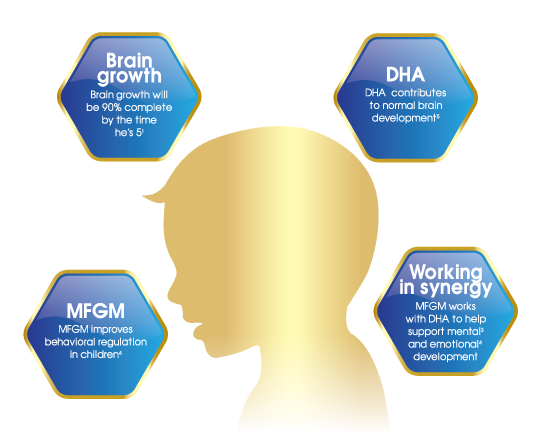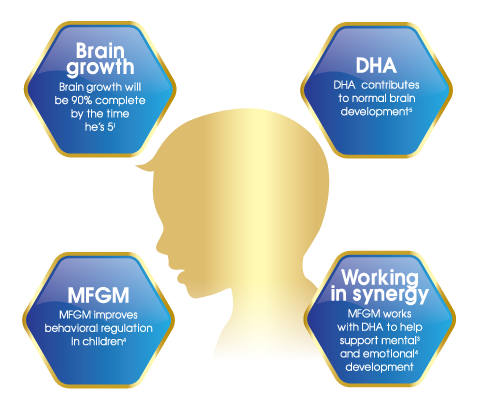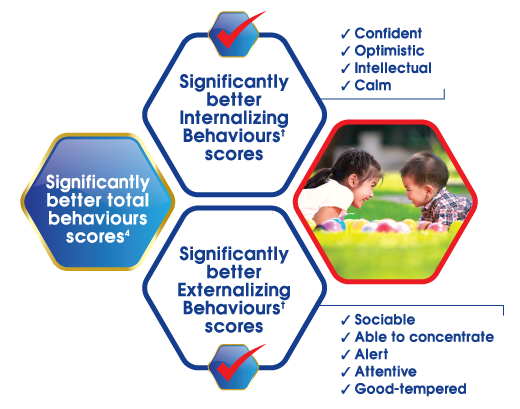MFGM Scientific Support
Why are MFGM & DHA Important Now?


A time to grow
Everything has its time for growth. For a child's brain, it's the first five years of life. By age five, brain growth will be 90% complete1.
MFGM and DHA are examples of brain-nourishing nutrients. Because his brain will never grow this fast again, MFGM & DHA are important for your child early years in life.
MFGM and DHA are examples of brain-nourishing nutrients. Because his brain will never grow this fast again, MFGM & DHA are important for your child early years in life.
Preparing for the future
A high IQ only makes up half the equation in the formula for future success. The other half lies in EQ. It has been proven that future success certainly goes beyond just mere intelligence and academics.
There exists a demand for personal soft skills and emotional intelligence; skills such as communication, problem-solving, collaboration and more.
There exists a demand for personal soft skills and emotional intelligence; skills such as communication, problem-solving, collaboration and more.
Benefits for Your Child's Brain


|
MFGM & DHA Scientific Studies
Cognitive Development
DHA has been shown to be associated with better reading and working memory performance6.
Emotional & Behavioral Regulation
The first five years of life is a critical period for the development of social competence that is linked to emotional well-being. It can affect a child’s later ability to functionally adapt in school and to form successful relationships throughout life.


MFGM components* promote production and transmission of neurotransmitters9,10 (substances that participate in the creation of brain cell connections) and thereby regulate mental abilities, emotions and mood11. They also form a sheath that coats, insulates and protects nerve cells within the brain, helping them to become more stable to transmit information faster12,13. Scientific study show that MFGM consumption leads to improved emotional and behavioral regulation in young children4.


Building Immunity
MFGM has been shown to have a protective effect against gastrointestinal infections, producing a significant decrease in the number of short febrile episodes4.
References:
1Lenroot RK and Giedd JN. Neuroscience and Biobehvaioral Reviews 2006; 30:718-729
2Accenture. 2017. Available at https://www.accenture.com/us-en/insight-iq-plus-eq [accessed on 18th April 2017]
3Kuratko CN. et al. Nutrients. 2013; 5(7), 2777-2810.
4Veereman-Wauters G et al. Nutrition. 2012;28:749-752
5EFSA NSDA Panel. EFSA Journal. 2014;12(10):3840, 8 pp. doi:10.2903/j.efsa.2014.3840
6Montgomery P et al. PLoS ONE. 2013; 8(6): e66697. doi:10.1371/journal.pone.0066697
7Sandjaja et al. British Journal of Nutrition. 2013; 110:S57-S64
8Graziano et al. J Sch Psychol. 2007;45(1):3-19
9El-Loly M. Pol. J. Food Nutr. Sci. 2011; 61(1),7-32.
10Küllenberg D et al. Lipids in Health and Disease. 2012; 11(3),1=16
11Banjari I et al. Hrana u zdravlju i bolesti, znanstveno-stručni časopis za nutricionizam i dijetetiku, 2014; 3(1),13-21
12Kang, H. & Klauda JB. Biophysical Journal. 2015; 108(2), Supplement 1, p410a
13Melendez S. How to strengthen your brain. Melendez Publishing International. 2010; p98.
*MFGM components refer to sphingomyelin and phospholipids
†Behaviour terms are adapted based on Merriam-Webster English Thesaurus.







